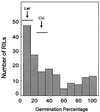Genetic analysis of seed-soluble oligosaccharides in relation to seed storability of Arabidopsis
- PMID: 11115877
- PMCID: PMC59858
- DOI: 10.1104/pp.124.4.1595
Genetic analysis of seed-soluble oligosaccharides in relation to seed storability of Arabidopsis
Abstract
Seed oligosaccharides (OSs) and especially raffinose series OSs (RSOs) are hypothesized to play an important role in the acquisition of desiccation tolerance and consequently in seed storability. In the present work we analyzed the seed-soluble OS (sucrose, raffinose, and stachyose) content of several Arabidopsis accessions and thus identified the genotype Cape Verde Islands having a very low RSO content. By performing quantitative trait loci (QTL) mapping in a recombinant inbred line population, we found one major QTL responsible for the practically monogenic segregation of seed stachyose content. This locus also affected the content of the two other OSs, sucrose, and raffinose. Two candidate genes encoding respectively for galactinol synthase and raffinose synthase were located within the genomic region around this major QTL. In addition, three smaller-effect QTL were identified, each one specifically affecting the content of an individual OS. Seed storability was analyzed in the same recombinant inbred line population by measuring viability (germination) under two different seed aging assays: after natural aging during 4 years of dry storage at room temperature and after artificial aging induced by a controlled deterioration test. Thus, four QTL responsible for the variation of this trait were mapped. Comparison of the QTL genetic positions showed that the genomic region containing the major OS locus did not significantly affect the seed storability. We concluded that in the studied material neither RSOs nor sucrose content had a specific effect on seed storability.
Figures







References
-
- Alonso-Blanco C, Koornneef M. Naturally occurring variation in Arabidopsis: an underexploited resource for plant genetics. Trends Plant Sci. 2000;5:22–29. - PubMed
-
- Alonso-Blanco C, Peeters AJM, Koornneef M, Lister C, Dean C, van den Bosch N, Pot J, Kuiper MTR. Development of an AFLP based linkage map of Ler, Col and Cvi Arabidopsis thaliana ecotypes and construction of a Ler/Cvi recombinant inbred line population. Plant J. 1998b;14:259–271. - PubMed
-
- Beebe DU, Turgeon R. Localization of galactinol, raffinose, and stachyose synthesis in Cucurbita pepo leaves. Planta. 1992;188:354–361. - PubMed
Publication types
MeSH terms
Substances
LinkOut - more resources
Full Text Sources

